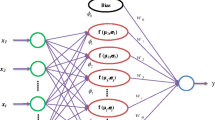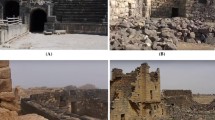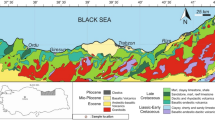Abstract
Slake durability index (I d2) is an important engineering parameter to assess the resistance of clay-bearing and weak rocks to erosion and degradation. Standard test sample preparation for slake durability test is difficult for some rock types and the test is time-consuming. The paper reports an attempt to define I d2 using other parameters that are simpler to obtain. In this study, three different artificial neural network approaches, namely feed-forward back propagation (FFBP), radial basis function based neural network (RBNN), and generalized regression neural networks (GRNN) were used for estimating I d2. The determination coefficient (R 2), root mean square error and mean absolute relative error statistics were used as evaluation criteria of the FFBP, RBNN, and GRNN models. The experimental results were compared with these models. The comparison results indicate that the GRNN models are superior to the FFBP and RBNN models in modeling of the slake durability index (I d2).





Similar content being viewed by others
References
ASTM (1990) Standard test method for slake slake durability of shales and similar weak rocks (D4644). Annual Book of ASTM Standards
Bilhan O, Emiroglu ME, Kisi O (2010) Application of two different neural network techniques to lateral outflow over rectangular side weirs located on a straight channel. Adv Eng Softw 41:831–837
Broomhead DS, Lowe D (1988) Multi-variable functional interpolation and adaptive networks. Complex Sys 2:321–355
Cetin H, Laman M, Ertunc A (2000) Settlement and slaking problems in the world’s fourth largest rock-fill dam, the Ataturk Dam in Turkey. Eng Geol 56:225–242
Chen CH, Ke CC, Wang CL (2009) A back-propagation network for the assessment of susceptibility to rock slope failure in the eastern portion of the Southern Cross-Island Highway in Taiwan. Environ Geol 57:723–733
Cybenco G (1989) Approximation by superposition of a sigmoidal function. Math Control Signal 2:303–314
Das SK, Biswal RK, Sivakugan N, Das B (2011) Classification of slopes and prediction of factor of safety using differential evolution neural networks. Environ Earth Sci 64(1):201–210
Dawson WC, Wilby R (1998) An artificial neural network approach to rainfall-runoff modeling. Hydrol Sci J 43(1):47–66
Dhakal G, Yoneda T, Kato M, Kaneko K (2002) Slake durability and mineralogical properties of some pyroclastic and sedimentary rocks. Eng Geol 65:31–34
Fang YC, Wu BW (2007) Neural network application for thermal image recognition on flow-resolution objects. J Opt A Pure Appl Opt 9(2):134–144
Firat M, Turan ME, Yurdusev MA (2010) Comparative analysis of neural network techniques for predicting water consumption time series. J Hydrol 38:446–451
Franklin JA, Chandra R (1972) The slake durability test. Int J Rock Mech Min 9:325–341
Gencel O, Kocabas F, Gok MS, Koksal F (2011) Comparison of artificial neural networks and general linear model approaches for the analysis of abrasive wear of concrete. Constr Build Mater 25:3486–3494
Gokceoglu C, Zorlu K (2000) A fuzzy model to predict the uniaxial compressive strength and the modulus of elasticity a problematic rock. Eng Appl Artif Intel 17:61–72
Gokceoglu C, Ulusay R, Sonmez H (2000) Factor effecting the durability of selected weak and clay-bearing rocks from Turkey, with particular emphasis on the influence of the number of drying and wetting cycles. Eng Geol 57:215–237
Gunaydın O (2009) Estimation of soil compaction parameters by using statistical analyses and artificial neural networks. Environ Geol 57:203–215
Hagan MT, Menhaj M (1994) Training feedforward networks with the Marquardt algorithm. IEEE Trans Neural Netw 5(6):989–993
Haykin S (1999) Neural networks: a comprehensive foundation, 2nd edn. Prentice-Hall, Englewood Cliffs
Hornik K, Stinchcombe M, White H (1989) Multilayer feedforward networks are universal approximators. Neural Netw 2:359–366
Ikizler SB, Aytekin M, Vekli M, Kocabas F (2010) Prediction of swelling pressures of expansive soils using artificial neural networks. Adv Eng Softw 41:647–655
ISRM (2007) In: Ulusay R, Hudson JA (eds) The complete ISRM suggested methods for rock characterization, testing and monitoring: 1974–2006
Kalkan E, Akbulut S, Tortum A, Samet C (2009) Prediction of the unconfined compressive strength of compacted granular soils by using inference systems. Environ Geol 58:1429–1440
Kayabali K, Beyaz T, Kolay E (2006) The effect of the ph of the testing liquid on the slake durability of gypsum. Bull Eng Geol Environ 65:65–71
Kim B, Kim S, Kim K (2003) Modelling of plasma etching using a generalized regression neural network. Vacuum 71:497–503
Kisi O (2004) Multi-layer perceptrons with Levenberg Marquardt training algorithm for suspended sediment concentration prediction and estimation. Hydrolog Sci J 49(6):1025–1040
Kisi O (2005) Suspended sediment estimation using neuro-fuzzy and neural network approaches. Hydrolog Sci J 50(4):683–696
Kisi O (2007) Streamflow forecasting using different artificial neural network algorithms. J Hydrol Eng ASCE 12(5):532–539
Kisi O (2008) The potential of different ANN techniques in evapotranspiration modeling. Hydrol Process 22:2449–2460
Kocabas F, Unal S (2010) Compared techniques for the critical submergence of an intake in water flow. Adv Eng Softw 41:802–809
Kolay E, Kayabali K (2006) Investigation of the effect of aggregate shape and surface roughness on the slake durability index using the fractal dimension approach. Eng Geol 86:271–284
Kolay E, Kayabali K, Tasdemir Y (2010) Modeling the slake durability index using regression analysis, artificial neural networks and adaptive neuro-fuzzy methods. Bull Eng Geol Environ 69:275–286
Koncagul E, Santi PM (1998) Predicting the unconfined compressive strength of the Breathitt shale using slake durability, Shore hardness and rock structural properties. Int J Rock Mech Min 36:139–153
Lee GC, Chang SH (2003) Radial basis function networks applied to DNBR calculation in digital core protection systems. Ann Nucl Energy 30:1561–1572
Leonard JA, Kramer MA, Ungar LH (1992) Using radial basis functions to approximate a function and its error bounds. IEEE Trans Neural Netw 3:624–627
Lu Y (2005) Underground blast induced ground shock and its modelling using artificial neural network. Comput Geotech 32:164–178
Mandelbrot BB (1967) How long is the coast of Great Britain: statical self similarity and the fractional dimension. Science 156:636–638
Mazesko J, Gniot R (2008) Application of neural networks for the prediction of total phosphorus concentrations in surface waters. Polish J Environ Stud 17(3):363–368
Parlak A, Islamoglu Y, Yasar H, Egrisogut A (2006) Application of artificial neural network to predict specific fuel consumption and exhaust temperature for a diesel engine. Appl Therm Eng 26(8–9):824–828
Partal T (2009) River flow forecasting using different artificial neural network algorithms and wavelet transform. Can J Civil Eng 36:26–39
Poggio T, Girosi F (1990) Regularization algorithms for learning that are equivalent to multilayer networks. Science 2247:978–982
Rezaee MR, Kadkhodaie IA, Barabadi A (2007) Prediction of shear wave velocity from petrophysical data utilizing intelligent systems: an example from a sandstone reservoir of Carnarvon Basin, Australia. J Petrol Sci Eng 55:201–212
Rooki R, Ardejani FD, Aryafar A, Asadi AB (2011) Prediction of heavy metals in acid mine drainage using artificial neural network from the Shur River of the Sarcheshmeh porphyry copper mine, Southeast Iran. Environ Earth Sci 64(5):1303–1316
Sen Z (2004) Principals of artificial neural networks. Water Foundation Publications, Istanbul (in Turkish)
Singh TN, Verma AK, Singh V, Sahu A (2005) Slake durability study of shaly rock and its predictions. Environ Geol 47:246–253
Singh TN, Sinha S, Singh VK (2007) Prediction of thermal conductivity of rock through physico-mechanical properties. Build Environ 42:146–155
Specht DF (1991) A general regression neural network. IEEE Trans Neural Netw 2(6):568–576
Sreekanth PD, Sreedevi PD, Ahmed S, Geethanjali N (2011) Comparison of FFNN and ANFIS models for estimating groundwater level. Environ Earth Sci 62(6):1301–1310
Sudheer KP, Gosain AK, Ramasastri KS (2003) Estimating actual evapotranspiration from limited climatic data using neural computing technique. J Irrigat Drain Eng 129(3):214–218
Tanrikulu AE (2009) Application of ANN techniques for estimating modal dam** of impact-damped flexible beams. Adv Eng Softw 40:986–990
Turcotte DL (1992) Fractal and chaos in geology and geophysics. Cambridge University Press, Cambridge
Vallejo LE (1994) Fractal analysis of the slake durability test. Can Geotech J 31:1003–1008
Wang ZQ, Wu Q, Zhang YT, Cheng JM (2011) Confined groundwater pollution mechanism and vulnerability assessment in oilfields, North China. Environ Earth Sci 64(6):1547–1553
Yilmaz I (2010) Comparison of landslide susceptibility map** methodologies for koyulhisar, Turkey: conditional probability, logistic regression, artificial neural networks, and support vector machine. Environ Earth Sci 61(4):821–836
Yilmaz I, Karacan E (2005) Slaking durability and its effect on the doline occurrence in the gypsum. Environ Geol 47(7):1010–1016
Yilmaz T, Seckin G, Yuceer A (2010) Modeling of effluent COD in UAF reactor treating cyanide containing wastewater using artificial neural network approaches. Adv Eng Softw 41:1005–1010
Yukselen Y, Erzin Y (2008) Artificial neural networks approach for zeta potential of Montmorillonite in the presence of different cations. Environ Geol 54:1059–1066
Author information
Authors and Affiliations
Corresponding author
Rights and permissions
About this article
Cite this article
Tasdemir, Y., Kolay, E. & Kayabali, K. Comparison of three artificial neural network approaches for estimating of slake durability index. Environ Earth Sci 68, 23–31 (2013). https://doi.org/10.1007/s12665-012-1702-3
Received:
Accepted:
Published:
Issue Date:
DOI: https://doi.org/10.1007/s12665-012-1702-3




